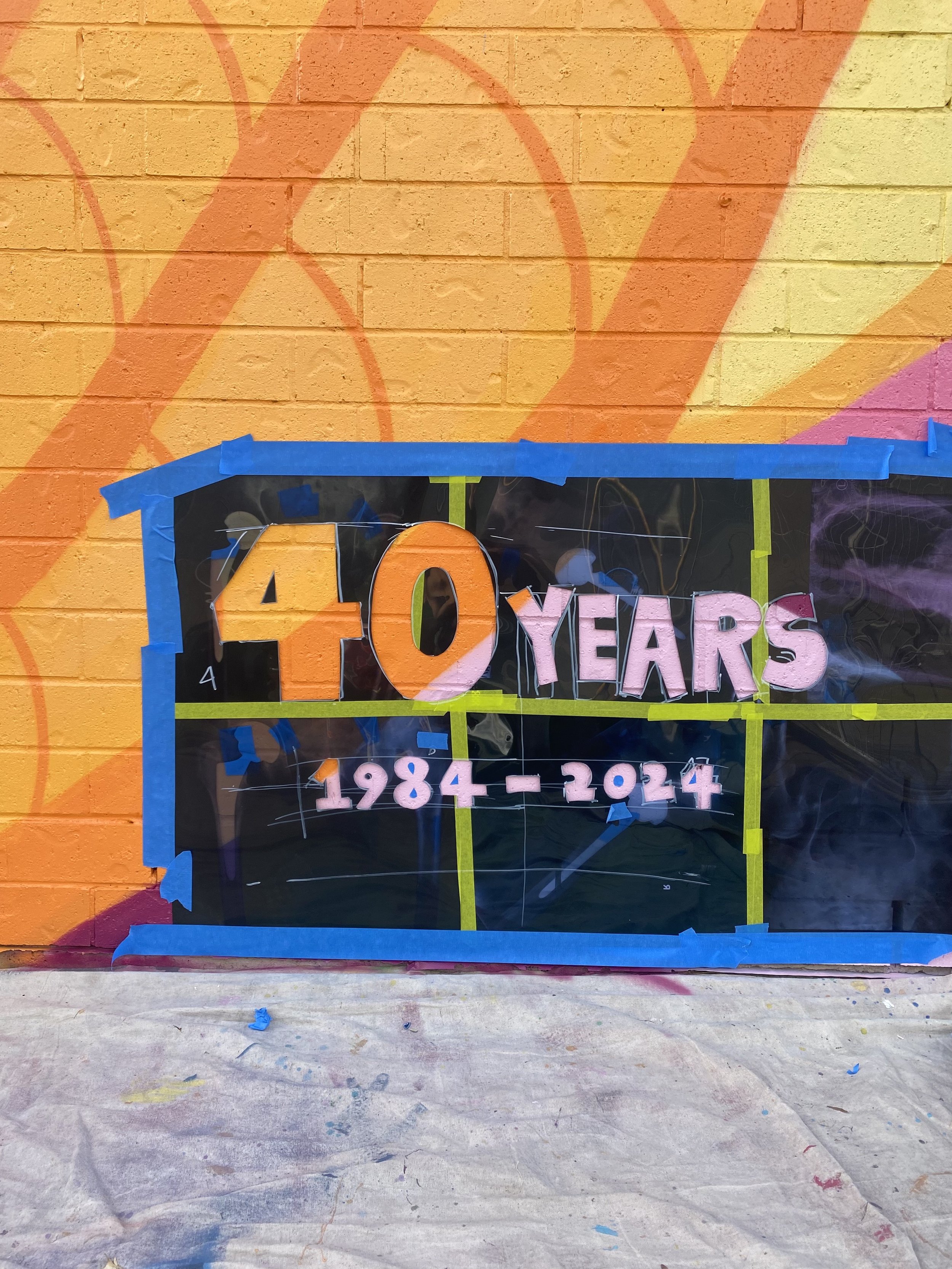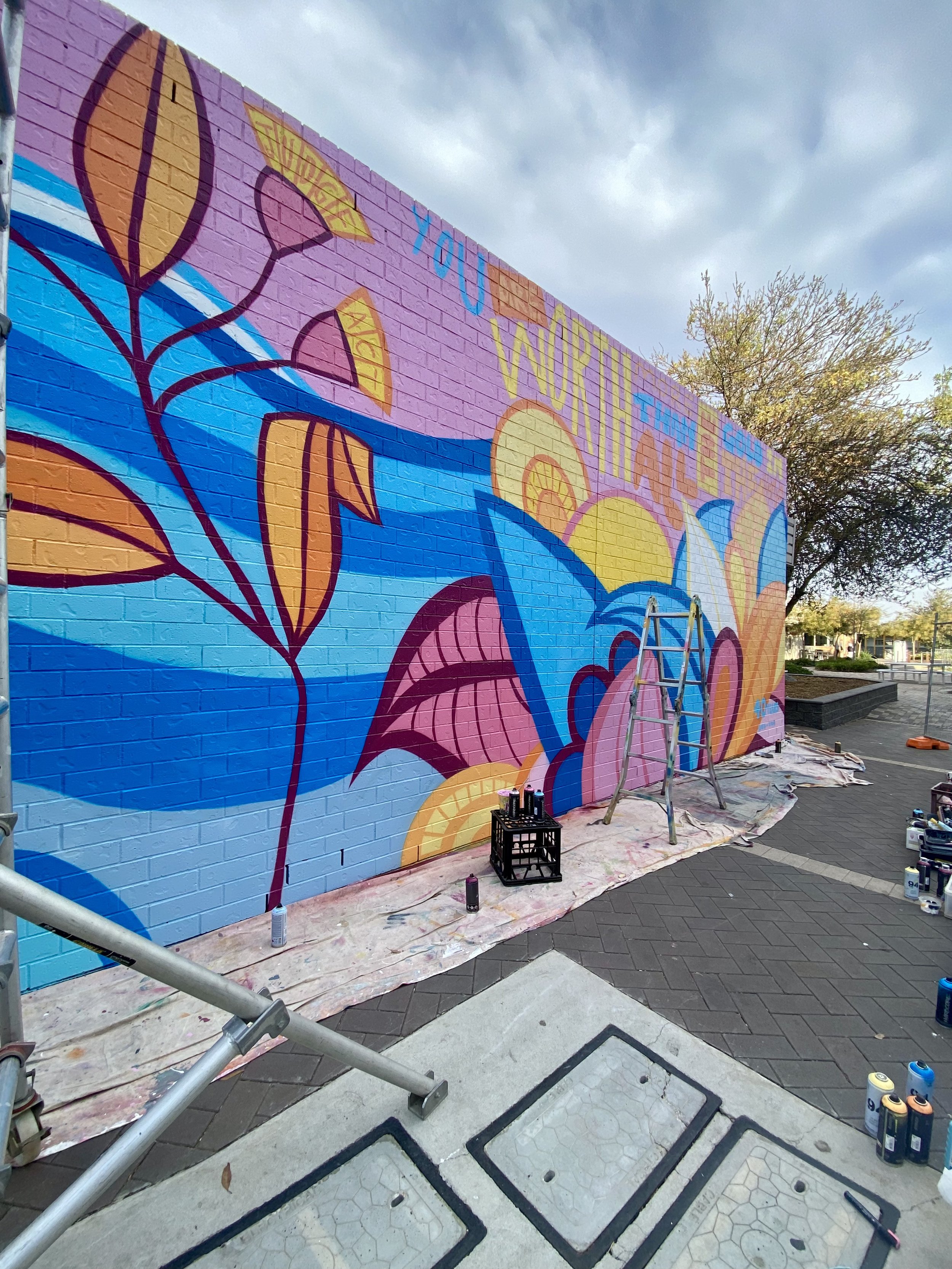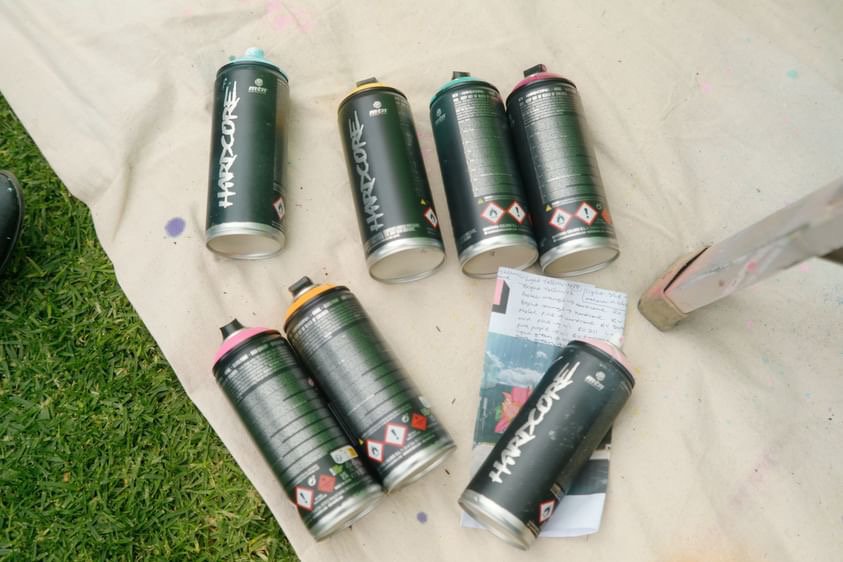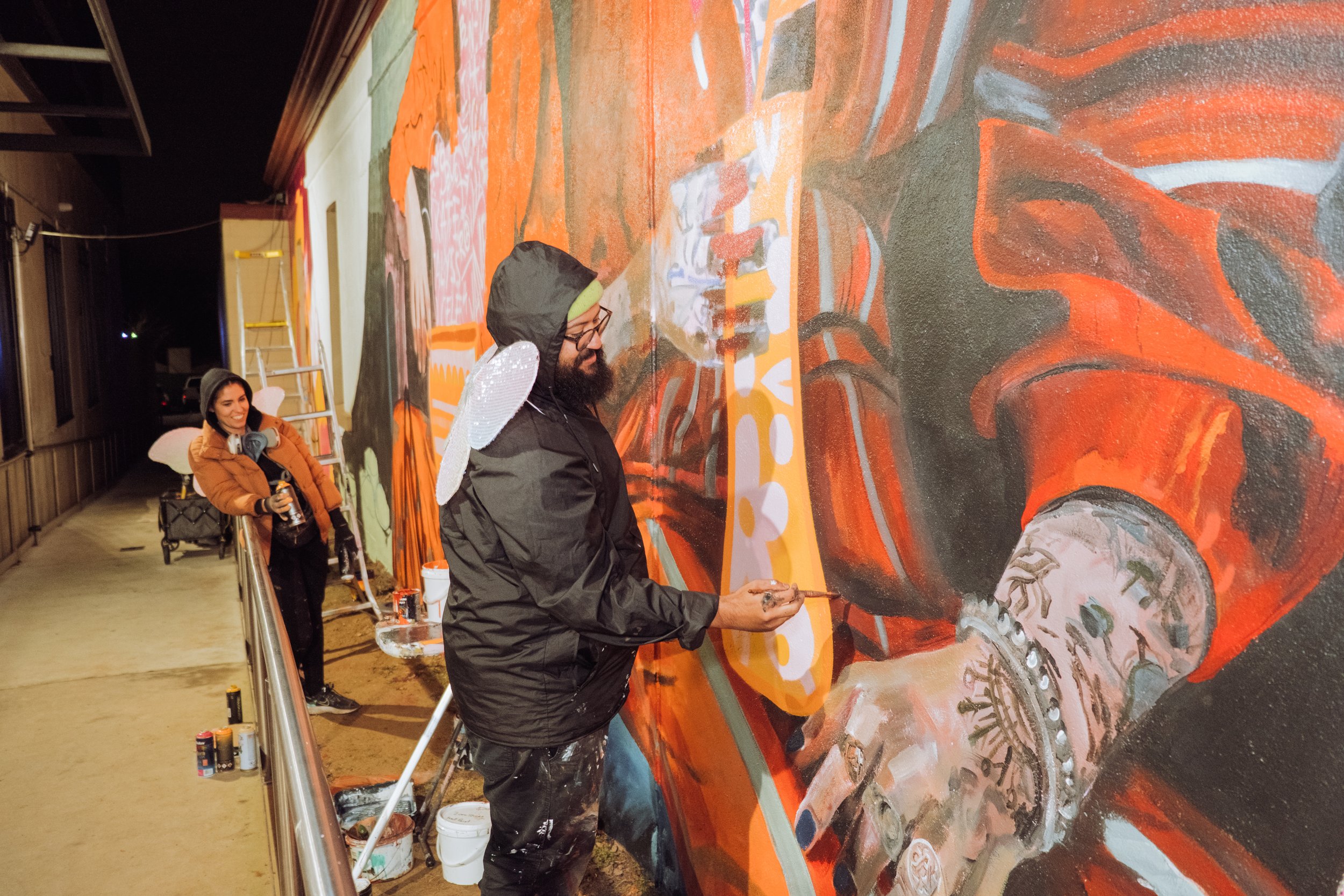Frequently Asked Questions from High School Students
As an artist in residence at high schools and from regular email’s I’ve received, I have compiled the most common questions that students ask me. I am an open book, I want others to have the information I so desperately wanted when I was starting out.
I hope this helps teachers, students, and emerging artists. Teenagers are honest and ask the questions adults can shy away from.
Thank you to the many students who have contributed to this interview blog format. I’ve had students from Thomas More College, Cardijn College, Emmaus Christian School, Wilderness School and many more.
If you have a question you’d like answered, please let me know! I’d be happy to add my response to the blog.
How do you scale up your design?
I freehand most of my murals. I sketch it out with aerosol, step back and make adjustments. Sometimes I use stencils in the design. I love to include lace patterns or stencil my logo.
If the design is particularly detailed or involves text, I use a doodle grid. This involves drawing random symbols, overlaying your design on a photo of the wall with symbols and then drawing from that reference image. Using a traditional grid, like you might at school to up-scale a design, becomes hard to do when you are standing so close to the wall and can’t tell what square you are up to. The doodle grid allows you to tell exactly where you are up to on your design. I also know many artists that use a projector to scale their work.
You can see more progress photos of freehand aerosol sketching on this childcare mural project in Whyalla.
Cardijn College was celebrating 40 years. I made this stencil with old x-rays for the lettering.
The rest of this mural for Cardijn College in 2024, was completely freehand with aerosol and acrylic paint.
How much do you get paid?
Such a bold question! Every project is different because of the size, design and location. I try and accurately quote so that I account for materials, travel, insurance, hire equipment, GST, tax, super and any other costs involved with the project.
Based on all of that and the recommendations from NAVA, I charge between $220 - $260 + GST per square meter. You can see more about pricing here.
One of the factors you need to keep in mind, is that being a freelance artist means you are running a small business. That means that out of the money you make, you’re also paying for your website hosting, advertising, tax agent and many more behind the scenes costs.
I’ve also written a blog about how much a mural costs.
How long Does it take You to paint a mural?
It really does depend on the size of the wall. Sometimes it takes a few days to paint a wall, sometimes it takes weeks. The most time consuming part is the planning, often projects are first quoted 6 month or a year in advance.
Mural installation took 1 week.
Mural Installation took 2 weeks. (surface continues inside the building and around the building.)
How did you get your first mural gig?
I applied for an EOI (Expression of Interest) with the City of Adelaide in 2015. I was shortlisted for the project, but not successful when it came down to three artists and a panel interview. I was fortunate that they saw potential in me and offering me a mentorship with artist Fredrocker to learn from him as he painted a mural in Topham Mall.
I’m very grateful to Ed James, who was the Public Art Officer at the time who set up this opportunity. It also led to me meeting and working with Sarah Boese who was also mentored.
The lesson from my story is to keep applying for projects, even if you don’t think you're qualified or have enough experience. Every “no” has helped me learn and grow and it often leads you to new connections and opportunities in the future. When I get knocked back, I always request feedback. Along the way, I have always been practicing, experimenting and looking for ways to learn and build up my experience.
What aerosol brands do you use?
I love Montana spray paint. I usually buy Hardcore’s and 94s. They have a huge range and I particularly like the pressure in Hardcore’s.
What’s your favourite spray paint nozzle?
I use a mixture of fat caps and skinny nozzles. New York caps are a great fat cap, but my finger does get fatigued quickly. I also love banana caps when I’m painting detail and fine lines.
What is your main inspiration for your artwork?
Currently my work is heavily inspired by nature. It is always changing and evolving, but that is where I'm starting my projects and where I find endless ideas and solutions to artist briefs. I love looking at native plants and finding new patterns, colours and shapes.
How would you describe your work?
I predominantly use colour to express a feeling, mood or message in my work. My work explodes with colour and patterns that bring happiness and joy to the viewer. I often incorporate botanical elements.
How do you want people to react or feel about your work?
I want my work to delight and surprise the public. I love getting to experiment with the power of scale and how a simple colour on a wall can create a reaction. I am fascinated by our quest for happiness.
I’ve been considering where happiness is found, its duration, its departure and the waiting and anticipation for it to return. I aim to create connections through colour, movement and pattern.
Through experimenting with various mediums and scale, I challenge my practice and the viewers perception of their world. From canvas, to clay, to outdoor murals, my work is diverse yet my style is linked through a colour palette that expresses happiness.
How do you convey a particular emotion or thought through your work?
It’s a combination of a few things, but I consider colour to be the most powerful way to convey a feeling. I am personally very moved by colour. I remember standing in front of a Rothko work in America, about 10 years ago and just being totally consumed by his use of colour. His work is totally stripped back of anything representational and just allowed me to drink in the colour and find my own personal connection.
That’s now what I hope others experience when they see my murals. I love it when the viewer can actually have a different response than what I intended because the work belongs to them, it’s for them to interpret and find their own meaning.
I also find pattern and shape are wonderful tools to create movement in a piece that in a way complements the purpose of the colour by drawing the viewer's eye across a surface.
What artists are you inspired by?
MANY! Some of my favourite street artists are Jack Fran, Claire Foxton, Vans the Omega, Jasmine Crisp, Jimmy C, Rone and Lisa King.
I love many traditional artists like Auguste Rodin, Grace Crowley, Henri Matisse and Frida Kahlo.
I’m very fond of printmaking too, some of my favourite printmakers are Margaret Preston, Ellie Malin and Barbara Hanrahan.
Every time I’ve had the opportunity to see paintings in galleries by Claude Monet, Andy Warhol, Emily Kame Kngwarreye, Mark Rothko and Julie Dowling, I’ve been totally star-struck by their talent. Visiting the Louvre and seeing the Mona Lisa in person was particularly special too.
Contemporary artists that I admire and stalk on instagram all the time are Dana Kinter, Lena Baumgartner, Jessie Feitosa and Poh Ling Yeow.
I’m also inspired by emerging artists and students. I learn so much through teaching and sharing what I’m doing. But also through watching and listening to students.
What initially sparked your interest in creating art on the streets?
Art that is accessible to everyone and cleverly uses the urban environment to frame an artwork excites me. I visit galleries often, but I know that some people don’t and their experience of galleries can be quite intimidating. Art on the streets is for everyone and it can challenge, provoke or inspire the audience.
I love it’s temporal nature and the ability to embrace texture.
What Themes inspire your work? And how do you hope people will connect with your message?
Sometimes the theme is set by the client and other times you are able to fully come up with your design.
I follow what I’m interested in. What I find uncomfortable and what drives me to learn more.
At the moment, the direction I’m exploring is mental health, the impact of nature on our lives and body image.
I find that when I’m designing a mural, painting or working on the wheel, if I’m considering these ideas, it just naturally flows into the work. Sometimes it’s really intentional, and other times it's unexpected. When I take a step back and have an epiphany of the connection between what I’m feeling and what I’ve created. It’s quite moving when that happens. You know you’ve let go of fear and allowing creativity to skip your brain, and go directly from your heart to the surface you’re painting. It’s honestly like magic.
do you think your art can transfer into a smaller design?
Interesting question. I actually don’t think my work does transfer well into smaller designs 2D designs.
I love to paint big, bold shapes and when I put these designs onto greeting cards or smaller prints, I feel like the colour loses its impact.
I’ve noticed I much prefer my mural designs to be a photo with context of the street, to show scale. So if you can see the tree out the front and the roof of the building, the viewer can translate to an extent the impact of the mural.
Creating with clay and experimenting with my style on a 3D form has been really thrilling for me lately. However, I am already dreaming of going bigger with that too!
How do you select your colour palette?
I start by designing my murals by hand, in black and white. I have always liked to draw like this, I find it very relaxing.
I start to add colour when I’m working with the design on my computer and I have a photo of the location to help me experiment with colours.
I’m drawn to summer colours, pastel colours and lots of pink. It takes me back to my childhood and allows me to embrace everything I ran from when I “tried to grow up”.













